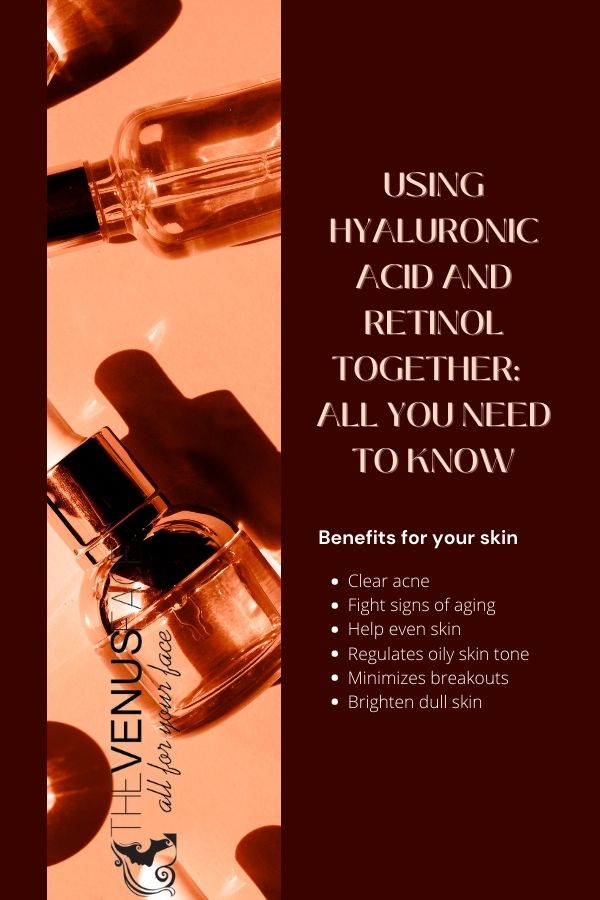In this blog post, you’ll learn how to use hyaluronic acid and retinol together.
Hyaluronic acid is a glycosaminoglycan, a type of molecule that is found naturally in the skin. It helps to keep the skin hydrated and plump by binding to water molecules. In addition, hyaluronic acid plays an important role in wound healing, as it helps to repair damaged tissue. Dermatologists often recommend products that contain hyaluronic acid to help reduce the appearance of wrinkles and fine lines.
Retinol is a vitamin A compound that is used in many skincare products. It is an important ingredient in the fight against wrinkles and other signs of aging. Retinol works by stimulating the production of new collagen, which helps to fill in wrinkles and give skin a more youthful appearance. It also helps to improve skin texture and tone. In addition, retinol can help to reduce the appearance of age spots and other forms of hyperpigmentation.
While it seems like a great idea to combine these two ingredients, it’s also essential to know how to use them correctly.

Can you use hyaluronic acid with retinol?
Yes, you can. The combination of retinol with hyaluronic acid provides an even greater benefit than the individual components would on their own. The two work together to help increase smoothness and reduce wrinkles while also preventing irritation that can be caused by retinol.
Can you mix hyaluronic acid with retinol?
Yes, you can. However, it is not necessary to “mix” the two ingredients together, as they will work just as well when applied one after the other. If you are using a product that contains both retinol and hyaluronic acid, then you know that the manufacturer has already done the work for you. But if you have the acid and the retinol in separate products, then read on.
How to use hyaluronic acid and retinol together
There are some steps you need to follow to layer these ingredients correctly.
Use a face wash
As a rule of thumb, before applying anything to your skin, you need to make sure that it’s clean. Use a gentle cleanser that will remove any dirt, makeup, or oil from your skin. This will help the hyaluronic acid and retinol penetrate your skin more easily. After washing your face, you should wait until it’s completely dry before applying any other products.
It’s also important to note that you should use the right face wash that is compatible with your skin type.
Apply the retinol first
Another basic rule is that retinol should always be applied before the acid. Usually, retinol often comes in the form of serums. So, you should apply it to your face and then wait around 30 mins for it to be absorbed by your skin before moving on to the next step.
While there are many types of skin care products containing retinol, the best form to use is a serum because it penetrates the skin more easily.
Apply hyaluronic acid later
After the retinol has had time to work its magic, it’s time to apply the hyaluronic acid. The acid often comes in the form of serums, so apply it to your face right after the retinol and then wait a few minutes for it to be absorbed. In case the acid comes in the form of moisturizers, then this would be the last step of your skincare routine.
Just like retinol, the best form of hyaluronic acid to use is a serum, too. However, since adding extra steps to your already long skincare routine can be time-consuming, you can also use a moisturizer that contains this ingredient.
Avoid sunray
Since retinol can make your skin more photo-sensitive, it’s important to avoid exposure to the sun. If you’re going to be spending time outdoors, make sure to apply sunscreen with an SPF of 30 or higher.
However, the best practice is to apply retinol and hyaluronic acid at night, before going to bed. This way, you can avoid exposure to sunlight and allow the ingredients to work their magic while you sleep, and you don’t have to use sunscreen.
Can you use retinol with niacinamide and hyaluronic acid?
In case you have 3 products, one with retinol, another with niacinamide, and the last one with hyaluronic acid and you’re wondering if you can use them all together, then the answer is yes. The correct order to layer these ingredients would be retinol first, hyaluronic acid after, and finally niacinamide.
Final thoughts
It is not rocket science when it comes to using skincare products, but it is essential to follow some basic rules. Applying retinol and hyaluronic acid correctly will help you achieve optimal results and avoid any irritation. And, as always, make sure to do a patch test before using any new product on your skin. Now that you know how to use these two ingredients, go out there and get the best skin of your life!
More:
- Using Salicylic Acid and Retinol Together (Mini Guide)
- Using Glycolic Acid and Retinol Together (Mini Guide)
- Using Azelaic Acid and Retinol Together (Mini Guide)
- Using Lactic Acid and Retinol Together (Mini Guide)
F.A.Q
Hyaluronic acid before or after retinol?
Hyaluronic acid should always be applied after retinol, as retinol can cause skin dryness.
Which is better retinol or hyaluronic acid?
These two ingredients are both beneficial for the skin and serve different purposes. Retinol can help to boost collagen production, while hyaluronic acid helps to keep the skin hydrated. Therefore it does not make sense to compare these two ingredients. Instead, consider using them together to get the best results for your skin.
Difference between retinol and hyaluronic acid?
They are totally different and serve different purposes. Retinol is a form of Vitamin A and works to speed up skin cell turnover and boost collagen production, while hyaluronic acid is a natural substance found in the body that helps lock in moisture.
Which is better for wrinkles retinol or hyaluronic acid?
Retinol is better for wrinkles because it helps to stimulate collagen production and improve skin elasticity. Hyaluronic acid is a good moisturizer, but it doesn’t have the same effect on wrinkles.
References: https://www.frontiersin.org/articles/10.3389/fmolb.2021.639666/full








